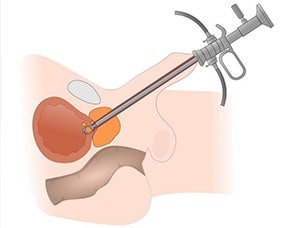A Transurethral Incision Of The Prostate (TUIP) is a prostate surgery that is performed to relieve the symptoms associated with an enlarged prostate gland, a condition known as benign prostatic hyperplasia (BPH). When the prostate becomes enlarged it can put pressure on the urethra and cause difficulty with urination. In the more severe cases of BPH the patient’s ability to pass urine can become completely blocked. Some urinary symptoms often associated with BPH include:
- A frequent or urgent need to urinate
- Difficulty starting urination
- The feeling you can’t completely empty your bladder
- Urinary tract infections
TUIP is a viable option for the treatment of an enlarged prostate depending on the severity of your symptoms and only if the swollen gland is relatively small, generally no more than an ounce or 30 milliliters in size.
Risks Of TUIP
Any risks or complications associated with this procedure are relatively low. Your doctor will discuss the potential risks which include:
- Temporary difficulty urinating
- Urinary tract infection (UTI)
- Erectile dysfunction
The Procedure
A TUIP procedure can typically take anywhere from 20 to 30 minutes to complete. Prior to the procedure you will either be administered a general anesthetic which will put you to sleep, or a regional anesthetic that will numb the specific area while you remain conscious. Once the anesthesia has taken effect the doctor will then insert insert a surgical instrument called a resectoscope into the tip of the penis and extend it into the the prostate. The resectoscope is a combined surgical instrument equipped with a camera, cutting device and valves to release fluid to irrigate the surgical area.
Using the resectoscope the doctor will then make one to two incisions in the prostate gland to relieve the pressure on the urethra. A catheter will then be inserted into the penis, through the urethra and into the bladder. The catheter is placed to help the bladder drain and flush out any blood clots. The urethra will swell following the surgery and the catheter will have to remain in place to help it stay open.
Following The Procedure
You will be in recovery for several hours following the surgery and have the options to either leave the facility or stay overnight. The catheter will have to remain in place for at least two days and there will be some pain and discomfort. Urination will be painful for a few weeks and patients can expect to have some blood in their urine normally directly following the procedure. To help with their recovery process patients are advised to:
- Drink plenty of water to flush out the bladder
- Avoid strenuous activity
- Refrain from using blood-thinning medications unless advised by your doctor
- Avoid constipation or strenuous bowel movements. Avoid fiber rich foods and only use a laxative if advised by your doctor
Make sure to follow-up with your doctor if you are still experiencing complications following your TUIP.


